Page 5 of 388
Comfort Controls and Audio Systems
Your Driving and the Road
Table of Contents (cont'd)
Your Driving, the Road and Your Vehicle
Defensive Driving
Drunken Driving
Control of a Vehicle
BrakingSteering
Driving Tips for Various Road Conditions
Recreational Vehicle Towing
Loading Your Vehicle
Towing a Trailer Heating and Air Conditioning
Setting the Radio ClockRadio/CD Player
Radio Theft-Deterrent Feature
Hazard Warning Flashers
Jump Starting
Towing Your VehicleEngine Overheating
Changing a Flat Tire
If You're Stuck
Problems on the Road
iii
Section
5
Section
4
Section
3
Page 96 of 388
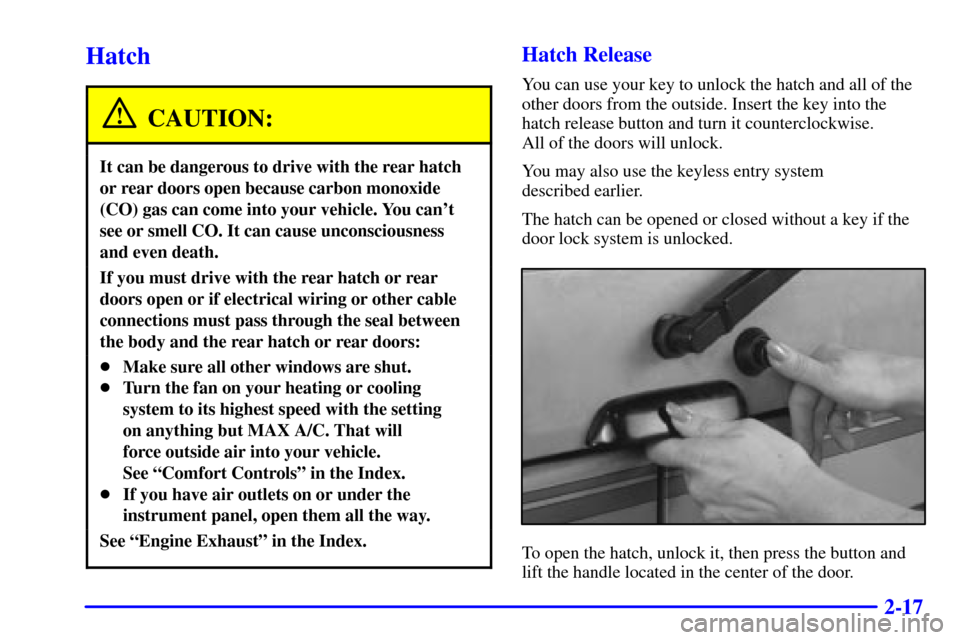
2-17
Hatch
CAUTION:
It can be dangerous to drive with the rear hatch
or rear doors open because carbon monoxide
(CO) gas can come into your vehicle. You can't
see or smell CO. It can cause unconsciousness
and even death.
If you must drive with the rear hatch or rear
doors open or if electrical wiring or other cable
connections must pass through the seal between
the body and the rear hatch or rear doors:
�Make sure all other windows are shut.
�Turn the fan on your heating or cooling
system to its highest speed with the setting
on anything but MAX A/C. That will
force outside air into your vehicle.
See ªComfort Controlsº in the Index.
�If you have air outlets on or under the
instrument panel, open them all the way.
See ªEngine Exhaustº in the Index.
Hatch Release
You can use your key to unlock the hatch and all of the
other doors from the outside. Insert the key into the
hatch release button and turn it counterclockwise.
All of the doors will unlock.
You may also use the keyless entry system
described earlier.
The hatch can be opened or closed without a key if the
door lock system is unlocked.
To open the hatch, unlock it, then press the button and
lift the handle located in the center of the door.
Page 134 of 388
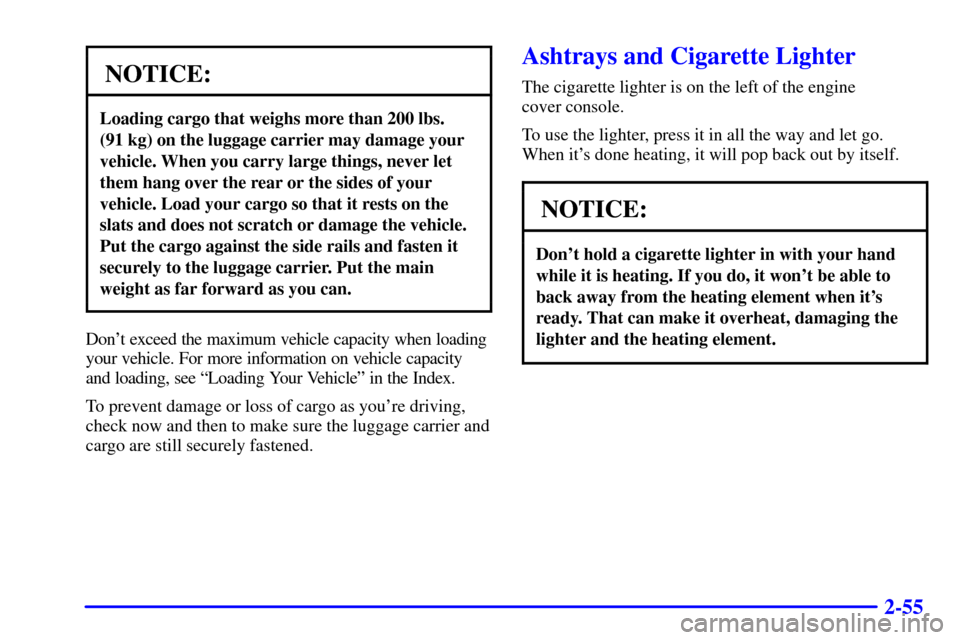
2-55
NOTICE:
Loading cargo that weighs more than 200 lbs.
(91 kg) on the luggage carrier may damage your
vehicle. When you carry large things, never let
them hang over the rear or the sides of your
vehicle. Load your cargo so that it rests on the
slats and does not scratch or damage the vehicle.
Put the cargo against the side rails and fasten it
securely to the luggage carrier. Put the main
weight as far forward as you can.
Don't exceed the maximum vehicle capacity when loading
your vehicle. For more information on vehicle capacity
and loading, see ªLoading Your Vehicleº in the Index.
To prevent damage or loss of cargo as you're driving,
check now and then to make sure the luggage carrier and
cargo are still securely fastened.
Ashtrays and Cigarette Lighter
The cigarette lighter is on the left of the engine
cover console.
To use the lighter, press it in all the way and let go.
When it's done heating, it will pop back out by itself.
NOTICE:
Don't hold a cigarette lighter in with your hand
while it is heating. If you do, it won't be able to
back away from the heating element when it's
ready. That can make it overheat, damaging the
lighter and the heating element.
Page 149 of 388
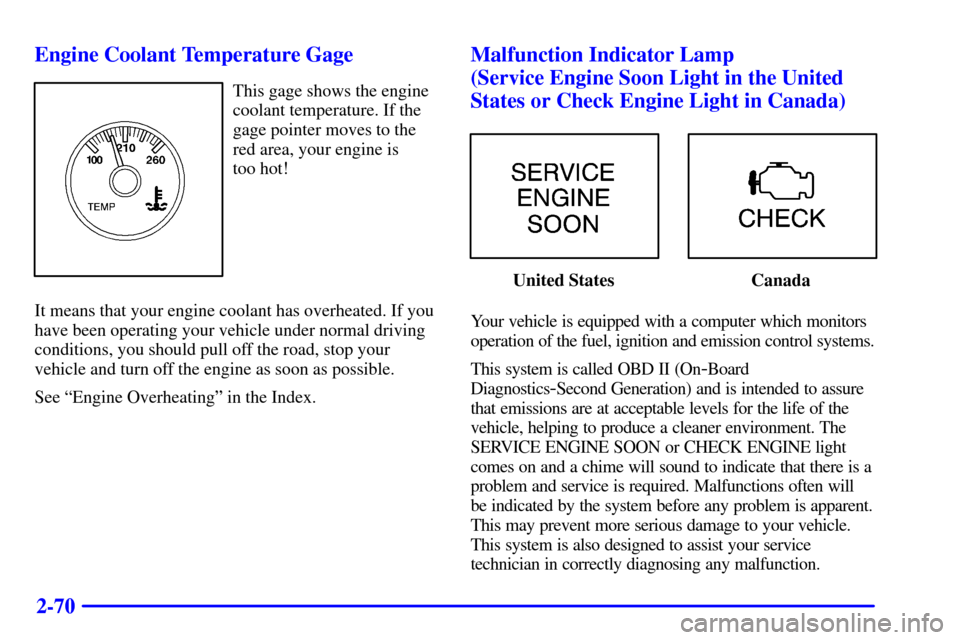
2-70 Engine Coolant Temperature Gage
This gage shows the engine
coolant temperature. If the
gage pointer moves to the
red area, your engine is
too hot!
It means that your engine coolant has overheated. If you
have been operating your vehicle under normal driving
conditions, you should pull off the road, stop your
vehicle and turn off the engine as soon as possible.
See ªEngine Overheatingº in the Index.
Malfunction Indicator Lamp
(Service Engine Soon Light in the United
States or Check Engine Light in Canada)
United States Canada
Your vehicle is equipped with a computer which monitors
operation of the fuel, ignition and emission control systems.
This system is called OBD II (On
-Board
Diagnostics
-Second Generation) and is intended to assure
that emissions are at acceptable levels for the life of the
vehicle, helping to produce a cleaner environment. The
SERVICE ENGINE SOON or CHECK ENGINE light
comes on and a chime will sound to indicate that there is a
problem and service is required. Malfunctions often will
be indicated by the system before any problem is apparent.
This may prevent more serious damage to your vehicle.
This system is also designed to assist your service
technician in correctly diagnosing any malfunction.
Page 157 of 388
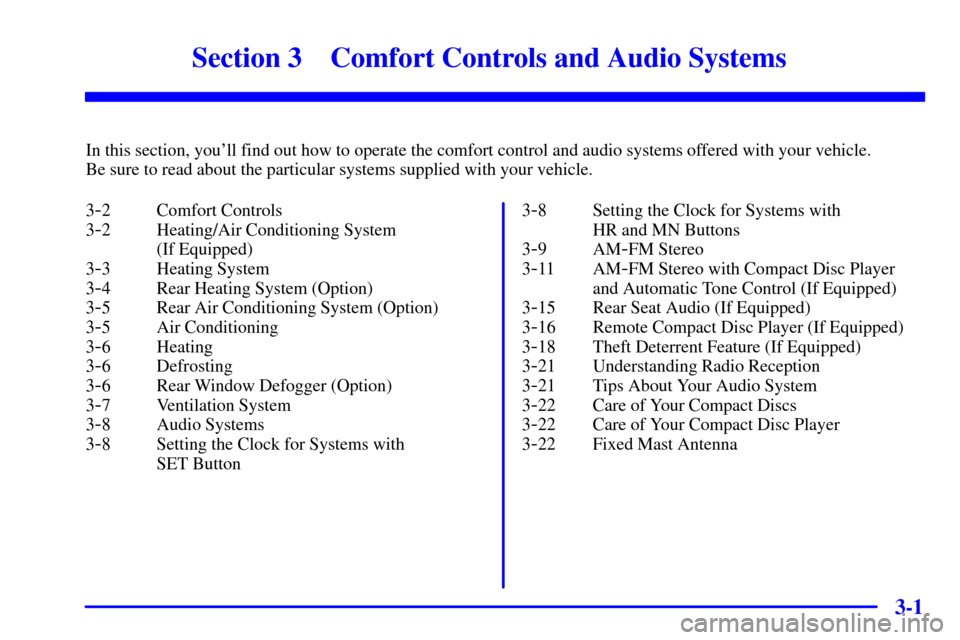
3-
3-1
Section 3 Comfort Controls and Audio Systems
In this section, you'll find out how to operate the comfort control and audio systems offered with your vehicle.
Be sure to read about the particular systems supplied with your vehicle.
3
-2 Comfort Controls
3
-2 Heating/Air Conditioning System
(If Equipped)
3
-3 Heating System
3
-4 Rear Heating System (Option)
3
-5 Rear Air Conditioning System (Option)
3
-5 Air Conditioning
3
-6 Heating
3
-6 Defrosting
3
-6 Rear Window Defogger (Option)
3
-7 Ventilation System
3
-8 Audio Systems
3
-8 Setting the Clock for Systems with
SET Button3
-8 Setting the Clock for Systems with
HR and MN Buttons
3
-9AM-FM Stereo
3
-11 AM-FM Stereo with Compact Disc Player
and Automatic Tone Control (If Equipped)
3
-15 Rear Seat Audio (If Equipped)
3
-16 Remote Compact Disc Player (If Equipped)
3
-18 Theft Deterrent Feature (If Equipped)
3
-21 Understanding Radio Reception
3
-21 Tips About Your Audio System
3
-22 Care of Your Compact Discs
3
-22 Care of Your Compact Disc Player
3
-22 Fixed Mast Antenna
Page 158 of 388
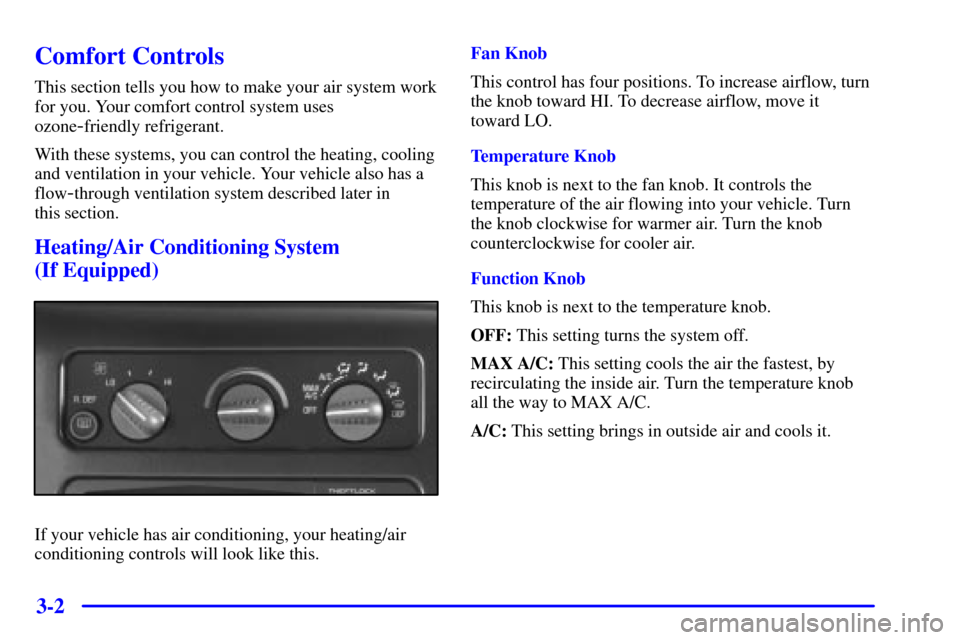
3-2
Comfort Controls
This section tells you how to make your air system work
for you. Your comfort control system uses
ozone
-friendly refrigerant.
With these systems, you can control the heating, cooling
and ventilation in your vehicle. Your vehicle also has a
flow
-through ventilation system described later in
this section.
Heating/Air Conditioning System
(If Equipped)
If your vehicle has air conditioning, your heating/air
conditioning controls will look like this.Fan Knob
This control has four positions. To increase airflow, turn
the knob toward HI. To decrease airflow, move it
toward LO.
Temperature Knob
This knob is next to the fan knob. It controls the
temperature of the air flowing into your vehicle. Turn
the knob clockwise for warmer air. Turn the knob
counterclockwise for cooler air.
Function Knob
This knob is next to the temperature knob.
OFF: This setting turns the system off.
MAX A/C: This setting cools the air the fastest, by
recirculating the inside air. Turn the temperature knob
all the way to MAX A/C.
A/C: This setting brings in outside air and cools it.
Page 159 of 388
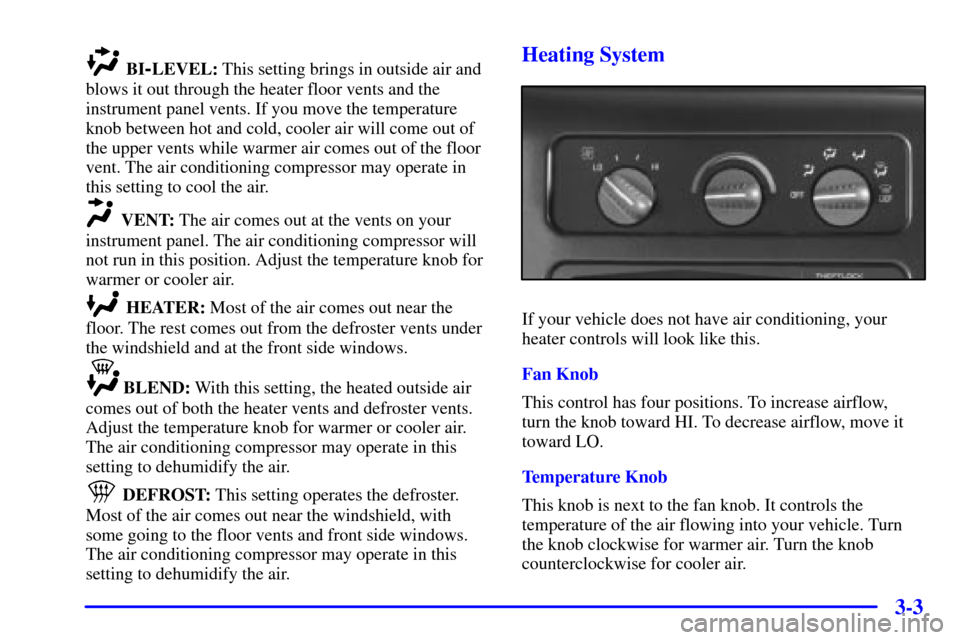
3-3
BI-LEVEL: This setting brings in outside air and
blows it out through the heater floor vents and the
instrument panel vents. If you move the temperature
knob between hot and cold, cooler air will come out of
the upper vents while warmer air comes out of the floor
vent. The air conditioning compressor may operate in
this setting to cool the air.
VENT: The air comes out at the vents on your
instrument panel. The air conditioning compressor will
not run in this position. Adjust the temperature knob for
warmer or cooler air.
HEATER: Most of the air comes out near the
floor. The rest comes out from the defroster vents under
the windshield and at the front side windows.
BLEND: With this setting, the heated outside air
comes out of both the heater vents and defroster vents.
Adjust the temperature knob for warmer or cooler air.
The air conditioning compressor may operate in this
setting to dehumidify the air.
DEFROST: This setting operates the defroster.
Most of the air comes out near the windshield, with
some going to the floor vents and front side windows.
The air conditioning compressor may operate in this
setting to dehumidify the air.
Heating System
If your vehicle does not have air conditioning, your
heater controls will look like this.
Fan Knob
This control has four positions. To increase airflow,
turn the knob toward HI. To decrease airflow, move it
toward LO.
Temperature Knob
This knob is next to the fan knob. It controls the
temperature of the air flowing into your vehicle. Turn
the knob clockwise for warmer air. Turn the knob
counterclockwise for cooler air.
Page 160 of 388
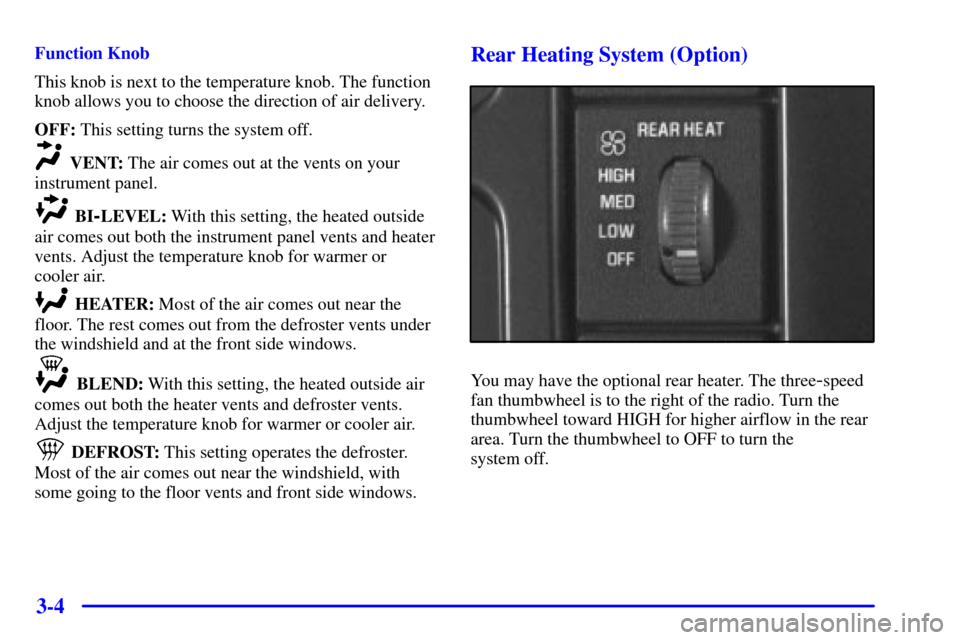
3-4
Function Knob
This knob is next to the temperature knob. The function
knob allows you to choose the direction of air delivery.
OFF: This setting turns the system off.
VENT: The air comes out at the vents on your
instrument panel.
BI-LEVEL: With this setting, the heated outside
air comes out both the instrument panel vents and heater
vents. Adjust the temperature knob for warmer or
cooler air.
HEATER: Most of the air comes out near the
floor. The rest comes out from the defroster vents under
the windshield and at the front side windows.
BLEND: With this setting, the heated outside air
comes out both the heater vents and defroster vents.
Adjust the temperature knob for warmer or cooler air.
DEFROST: This setting operates the defroster.
Most of the air comes out near the windshield, with
some going to the floor vents and front side windows.
Rear Heating System (Option)
You may have the optional rear heater. The three-speed
fan thumbwheel is to the right of the radio. Turn the
thumbwheel toward HIGH for higher airflow in the rear
area. Turn the thumbwheel to OFF to turn the
system off.